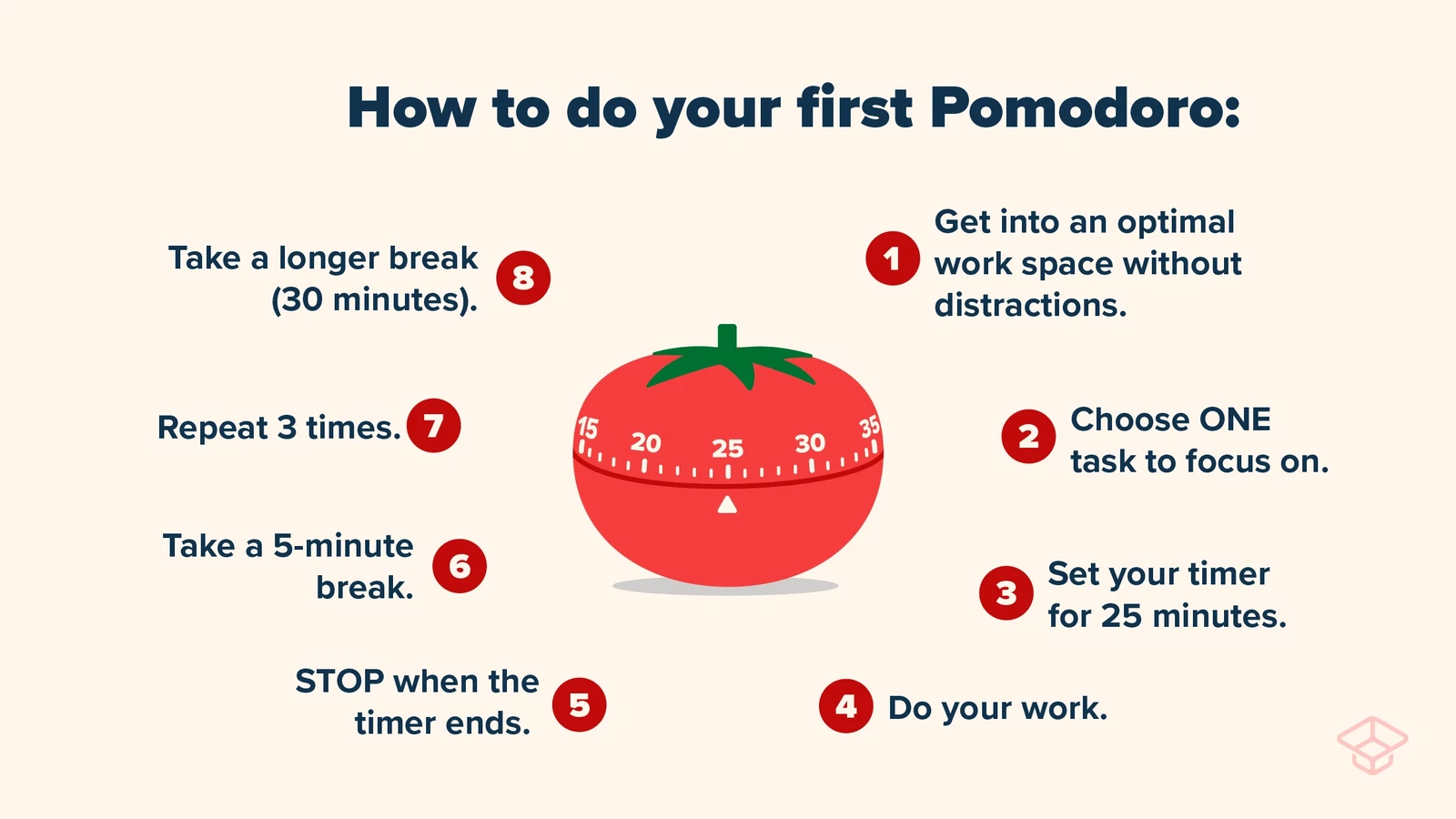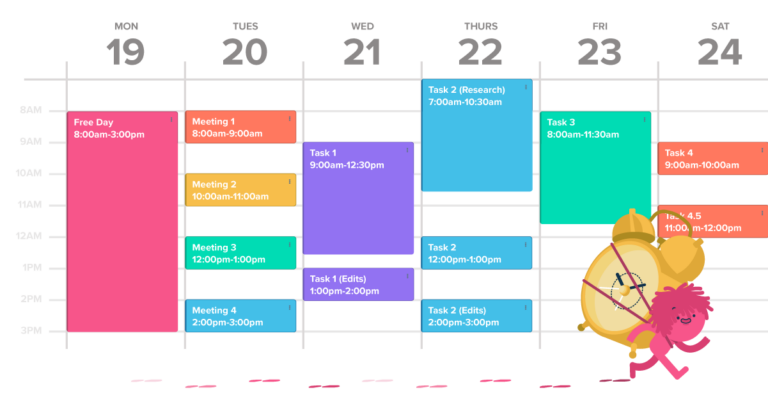Meaning of Pomodoro: Where Does the Name come from? 🍅
The Pomodoro Technique is a time management method that has been proven to boost productivity and improve study habits. But where did the name “Pomodoro” come from? The technique was developed by Francesco Cirillo in the late 1980s, and he named it after the Italian word for tomato. This is because Cirillo used a tomato-shaped kitchen timer to track his work intervals, and the name “Pomodoro” has stuck ever since.

A tomato (“Pomodoro” in Italian) shaped kitchen timer was used by Francesco Cirillo when he first started using the Pomodoro technique which is where the name “Pomodoro Technique” comes from. Erato at Italian Wikinews., CC BY-SA 2.5
With the traditional Pomodoro technique, one work interval is 25 minutes long and is followed by a 5 to 10-minute break. You use these 25 minutes for pure, undistracted work where you stay 100% committed to the task at hand. And once your 25 minutes are up, you take your 5 to 10-minute break. You then repeat this about four times, and after that, you take a much longer break (here is when you can do some exercise, meditate, walk your dog, or take a nap).
Sounds pretty good, right? Especially if you’re struggling to start studying that scary-looking chapter on Thermodynamics or writing that introduction to your fourth essay this week.
Best Time Intervals to Use For The Pomodoro Technique
One of the most important aspects of using the Pomodoro Technique is finding the best time intervals that best work for you. You may choose to try start by trying out what studies suggest, such as the study conducted by Desktime that suggests 52-minute work and 17-minute break intervals, or you can try out time intervals based on the Ultradian Rhythms, which suggests 90-minute work and 20 or 30-minute break intervals.
This being said, it is safe to say that the time intervals that are the best for you depend on one major factor – you! Everyone has a different way of studying/working. Some may prefer shorter periods than the classic 25-minute work interval and do a 20-minute study/work, while others like long deep study/work intervals and choose to go with the Ultradian Rhythms. Of course, the same applies to your time intervals for your break as well. So we suggest you try the Pomodoro Technique and find your golden ratio.
After you decide which time intervals you are going to try first, it is time to choose your timer. You can go old style and purchase a physical timer that serves your taste or use one of the many online timers that will help you track your intervals. And, of course, we have some of the finest timers to choose from:
- StudySmarter App: We have a focus timer feature that you can use for your Pomodoro sessions – and you can set it to any time you want! If you want to find out more about how StudySmarter can help you be more productive with your studies, check out our post on our intelligent study planner.
- Pomofocus: Being one of the most known and simple Pomodoro tools out there makes Pomofocus a choice everyone starts with.
- Studywithme’s Aesthetic Pomodoro Timer: If you want a timer that can look cool on your PC screen and play a lo-fi playlist for studying, then this tool might be for you.
- Lo-fi Cafe: If you love some Lo-fi while studying, this tool can be in your browser bookmarks. While the website’s main purpose is to offer a calming live background and Lo-fi music, it also has a built-in Pomodoro timer that you can access from the top-right corner.
Pomodoro Study Method: How to Use Pomodoro
Time intervals are chosen, and the tool to track the time is ready, now let’s have a look at how you can use the Pomodoro Study Method to take your productivity and study sessions to the next level:
- Prioritize your task list and break your tasks into Pomodoro sessions (also called Pomodoros).
- Be mindful of distractions and try to eliminate them as much as possible.
- Set your timer for 25 minutes (or the time interval you have chosen).
- Start Studying/Working while focusing on one task each Pomodoro.
- When your timer goes off, take a 5-minute break (or the time interval you have chosen).
- Repeat for 3-4 Pomodoro Sessions and take a 20-30 minute break.
It is that simple! But of course, there are many factors while studying, and to cover all of them, you may want to implement these tips into your study sessions to make the most out of this proven study method:
- Group small tasks into one study/work session: Since it is better to focus on one thing per Pomodoro, to eliminate the chance of small tasks affecting your focus, you can group all of them into one session and get them done first to have a clear mind going forward.
- Don’t delay your sessions after the timer goes off: Whether you have completed a study/work interval or a break, one of the most crucial parts of this technique is managing your time according to the timer.
- Create a distraction-free study/work environment beforehand: The main goal of the technique is to enable you to work on a task without focusing on or thinking about anything else. Creating an environment that has no distractions to affect you is the best way to make sure you can stay 100% focused. To achieve this, you can clean your desk, get rid of anything that is not study/work related, put your phone on silent and put it away, and have some coffee or water with you to make sure you don’t have to interrupt your work if you get thirsty.
- Split big tasks into Pomodoros: If you don’t split your major tasks into different Pomodoros, you may cause the technique to work against you because it will cause you to feel like you have to finish a specific job in a particular time, which is not what we are aiming for.
- Focus on measuring your progress by the number of Pomodoros you have done: By doing so, you can make sure you don’t create any stress for yourself. Don’t focus on the big picture while working on it; instead, focus on the moment and how well you are studying/working. Remember, you can only take one step at a time and focusing on the 10th step ahead can only cause you to take the first 9 in the wrong direction.
Benefits of Using the Pomodoro Technique
Even though the Pomodoro technique is well-proven and useful, you may be wondering why it works so well and what is behind it. To answer that question, let’s have a look at the advantages of using the Pomodoro technique:
- Enhances Motivation: Motivation is a concept that is often misunderstood. You usually see motivation as something you must have before you start doing something, which can’t be further away from the truth. Motivation is something that you will get after you have completed the tiniest bit of your work, which is the concept behind the Korean proverb, which shows the wisdom of the ages and translates into English as “Starting is Half”. Even when you are not feeling like it, sitting down and studying/working for only 25 minutes is something everyone can do.
- Prevents Burnout: The concept of burnout is usually caused by overwhelming yourself with too much work while taking little to no breaks at all. Pomodoro Technique solves this issue by taking frequent breaks between your work sessions to calm down and prepare for another session.
- Increases Productivity: By breaking down work into manageable intervals, the Pomodoro Technique helps to eliminate procrastination and increase focus, resulting in more work getting done in less time.
- Improves Memory: By taking short breaks, the Pomodoro Technique allows the brain to process and retain information better, which leads to a better memorization of the material.
- Improves Time Management: By setting specific goals and deadlines for each Pomodoro and sticking to the deadlines, the technique helps to manage time more effectively and prioritize tasks more efficiently.
- Helps People with ADHD: For people with ADHD, the Pomodoro Technique can be very helpful since it helps to plan the day, reduce distractions, and improve focus. To make more extensive activities more doable, it divides them into smaller, more manageable pieces. The built-in breaks also assist you when you start to lose focus and give you a chance to get out of your head, which can help you release pent-up energy and focus better.
Alternatives to the Pomodoro Technique
While the Pomodoro technique is one of the most known and proven methods to enhance your productivity, if you are looking to mix up your routine, there are several other effective alternatives you can try:
- Using The Eisenhower Matrix: This method is based on the idea of dividing tasks into four categories: urgent and important, important but not urgent, urgent but not important, and not urgent or important. By prioritizing tasks based on these categories, you can better manage your time and focus on the most important tasks.
- Parkinson’s Law, states that work will expand to fill the time available for its completion. To overcome this, set shorter deadlines to stay on track and complete your tasks more efficiently.
- GTD Method (Getting Things Done): This method focuses on getting tasks out of your head and into a system, so you can focus on the task at hand instead of what needs to be done next.
About the Author
Oğulcan Tezcan is a writer, translator, editor, and an accomplished engineer. Oğulcan is also a keen researcher and digital market analyst, with a particular interest in self-development, productivity, and human behaviour.








